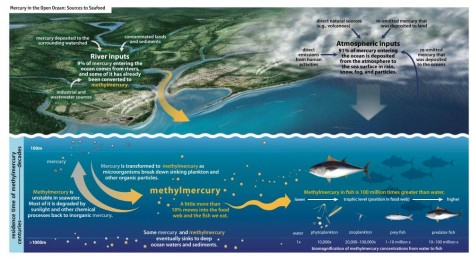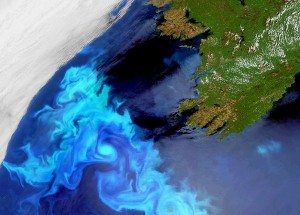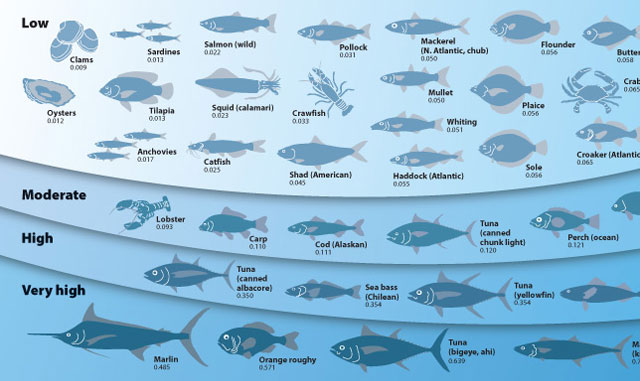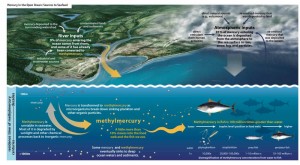
Ocean Pasture Plankton Blooms Scrub Mercury From The Surface Ocean
Crisis of high and rising mercury in the oceans is growing worse
Amount of toxic mercury to double by 2050
Nature’s cure is at hand
Article published here March 11, 2014 revised Feb. 2015
Fish such as swordfish and some tuna are now commonly so highly contaminated with mercury that health authorities advise that not more than one serving per week of such fish be consumed.
Pregnant women and young children are advised to eat none at all.
For me, I just don’t know what I would have done as a child if my mother had not punctuated my peanut butter and jelly sandwiches with regular tuna salad sandwiches. As you read on you’ll find the bad news about mercury in the oceans is not without a hopeful remedy being near to hand.
The reason mercury in the oceans is high and rising is that it is an abundant trace element in coal.
We are burning more and more coal every year and the mercury that goes up the smokestack from ten thousand coal-fired power plants and steel mills blows out to sea where it is poisoning our fish and us.
A new study just out shows there is three times more mercury in the ocean today than at the start of the industrial revolution some hundreds of years ago, Bad News for sure. But the other news in the report is that there is far less mercury in the ocean than we thought, Good News but not good enough. The less total mercury means we have a shot at working to knock the total amount way down.
What I find best in the new paper is, of course, the bit that supports my ideas. The papers lead author Carl Lamborg says, “It turns out that mercury clings to these microscopic (phytoplankton) life forms, traveling the same pathway as carbon and another important nutrient called phosphate. The team followed mercury’s path from the surface down to the ocean’s depths, and found that in the deep layers, the metal could be stored in the deep ocean for centuries on sluggish, cold currents.”
— — —
Update: Feb. 2015 — An additional paper in the journal Environmental Toxicology and Chemistry on Feb. 2, 2015 confirms that mercury is shown to be rising in Yellowfin Tuna in the Pacific at a rate of 3.8% per year! “Mercury levels are increasing globally in ocean water, and our study is the first to show a consequent increase in mercury in an open-water fish,” author Drevick of the University of Michigan says. “More stringent policies are needed to reduce releases of mercury into the atmosphere. If current deposition rates are maintained, North Pacific waters will double in mercury by 2050.“
— — —
Since there is already a dangerous, some would say deadly, level of mercury in the waters of this Blue Planet, it is not going to be enough to simply stop putting more in. Yes, we need to do that but more importantly, we have to deal with the first deadly dose we have already administered.
Fortunately, there is also a practical affordable solution/antidote to the mercury problem in our oceans.
On land where we encounter mercury in the environment the toxic problem arises when it moves about in water. The longer it remains in the water the more it becomes biologically activated and accumulates in fish and those fish become tasty toxic time bombs.
The sinister thing about mercury toxicity is that it doesn’t cause immediate deadly effects in fish or humans, rather it accumulates in us. Slowly over a long period of time, it poisons our organs and especially our brain.
The “Mad Hatter” of Alice in Wonderland was “mad” because hatters used an abundance of mercury in the making of felt to make hats. It shows up as symptoms much like those of senility, save that onset of mercury poisoned senility can begin even in childhood. Eventually, it will poison our bodies more broadly leading to a slow terrible death.
Natures Mercury Antidote
The best means of treating mercury, and many other chemical poisons, once they are in the environment, indeed the only practical means, is to create Nature-based biofilters of living aquatic plant life through which the poison laden waters pass and the poison is captured.
The more organic plant life the more micro-particulate and dissolved organic carbon is present both of which act as sticky chemical magnets for mercury and other toxins. The mercury and toxins bind to the organic carbon and sinks and is effectively buried in sediments, thus placed out of harm’s way for fish and us for geologic time.
This natural plant-powered bio-filtering is now a common practice in freshwater environments, it is the only thing we have found that we can employ to save us from our toxic mercury legacy. The only way the enormous amount of mercury and other toxins in the oceans might be reduced and mitigated is to sink it out of the life filled surface regions into the abyss and seabed where it will be buried in sediments and safely sent back into the deep earth for geologic time.
Restoring and Reviving Ocean Pastures Is The Natural Bio-Filter Solution
The means to do this is through the same organic carbon biofiltering made possible by employing aquatic plants, this time the plants are ocean phytoplankton. The more plankton, the more sticky toxin loving organic carbon, the more effective the mercury and toxin capture and sinking becomes.

Plankton blooms are the world’s most effective, indeed the oceans only mercury biofilters
Plankton blooms whether natural or intentionally created as I have proven is very possible and inexpensive and is the single means to effectively capture and move mercury in the environment safely away from fish and other life.
As horrible as our burning of fossil fuels is, pouring more mercury into the air and ocean, along with the CO2 from burning that fossil fuel is preventing plankton blooms from growing where they are needed most.
The greatest danger to the environment is waiting for someone else to save it.
Worst of all is doing nothing about it when the simple affordable solution is at hand. We have disturbed the balance of nature and we must act responsibly to help restore that balance. Thriving ocean pastures are unquestionably the worlds’ most efficient mercury scrubbers, natural chelators.
The vast majority of mercury in the presence of vibrant ocean plankton blooms is moved into the abyss in just a few weeks time leaving little to contaminate and poison fish that live nearer to the surface. The good news is that we can restore and replenish ocean pastures to a state of healthy abundance and that in doing so they will rapidly rid the world’s oceans of deadly mercury.
In a world with replenished, restored, and vibrant ocean pastures the global mercury crisis can be treated. In the bargain, we will enjoy restored oceans full of an abundance of healthy fish and best of all I may safely make and enjoy tuna fish salad sandwiches with my grandchildren.
This is important.
It’s a question of life or death. I choose life. And we’d best hurry!
UPDATE AUGUST 2014: Mercury in the Global Ocean – Study shows three times more mercury in upper ocean since Industrial Revolution
Analysis of their results showed rough agreement with the models used previously—that the ocean contains about 60,000 to 80,000 tons of pollution mercury. In addition, they found that ocean waters shallower than about 100 m (300 feet) have tripled in mercury concentration since the Industrial Revolution and that the ocean as a whole has shown an increase of roughly 10 percent over pre-industrial mercury levels.
“With the increases we’ve seen in the recent past, the next 50 years could very well add the same amount we’ve seen in the past 150,” said Lamborg. “The trouble is, we don’t know what it all means for fish and marine mammals. It likely means some fish also contain at least three times more mercury than 150 years ago, but it could be more.”












